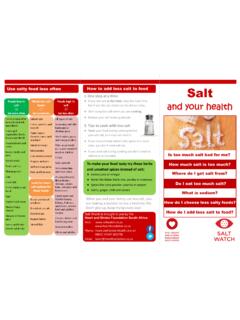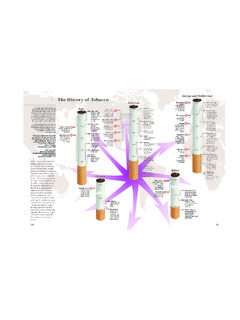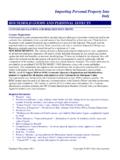Transcription of STATISTICS REFERENCE DOCUMENT - …
1 CARDIOVASCULAR DISEASE STATISTICS REFERENCE DOCUMENT Heart and Stroke Foundation South Africa Cardiovascular Disease STATISTICS REFERENCE DOCUMENT This DOCUMENT provides a brief summary of some key STATISTICS related to the burden of cardiovascular disease in South Africa, as well as the risk factors for cardiovascular disease. This DOCUMENT is not intended as an exhaustive collection of scientific literature or review of all available evidence, but rather as a convenient resource that can be used by healthcare professionals and the media for key STATISTICS regarding the burden of heart disease and stroke in South Africa. Compiled by: Heart and Stroke Foundation South Africa (HSFSA) Contributing authors: Jessica Byrne RD (SA), Gabriel Eksteen RD (SA), Christelle Crickmore MSc (Nutrition) Date: March 2016 About the Heart and Stroke Foundation South Africa The HSFSA plays a leading role in the fight against preventable heart disease and stroke, with the aim of seeing fewer South Africans suffer premature deaths and disabilities.
2 The HSFSA, established in 1980 is a non-governmental, non-profit organisation and has NPO and section 21 status. Heart and Stroke Foundation South Africa PO Box 15139 Vlaeberg 8018 021 422 1586 Disclaimer While all reasonable effort has been made to ensure the accuracy of information contained in this DOCUMENT , information may change from time to time without notice, as new developments occur. The HSFSA does not provide any representation or warranties, express or implied or assume any legal liability or responsibility for the accuracy, completeness or correctness, merchantability or usefulness of any of the information for any particular purpose. The HSFSA shall not be held liable for any direct, indirect, incidental, special, or consequential damages of any kind whatsoever and however caused, or arising in any way out of the use of the information contained in this DOCUMENT .
3 Burden of cardiovascular disease Cardiovascular disease (CVD, including heart disease and strokes) is the leading cause of disabilities and death worldwide, accounting for 17 million deaths a year (31% of total global deaths) 1. Up to 80% of CVD-related premature deaths in young people (< 65 years) are preventable through a healthy lifestyle a healthy diet, regular exercise and avoiding smoking 2. Once thought to be a disease associated with the elderly, more than half of deaths occur before age 65 3. Premature deaths caused by CVD in people of working age (35-64yrs) are expected to increase by 41% by 2030 4. South Africa CVD is the leading cause of death in South Africa after HIV/AIDS 5. More South Africans die of CVD than of all the cancers combined 5. CVD is responsible for almost 1 in 6 deaths ( ) in South Africa 6.
4 215 people die every day from heart disease or strokes 6. Every hour in South Africa: 5 people have heart attacks, 10 people have strokes and of those events, 10 people will actually die from it. Risk factors for cardiovascular disease Hypertension (high blood pressure) Hypertension is the leading risk factor for death from CVD, responsible for 13% of deaths globally. Of the various risk factors contributing to CVD, hypertension has the largest impact 7. Hypertension is the leading risk factor for stroke in South Africa, responsible for 1 in 2 (50%) strokes and 2 in 5 (42%) heart attacks 8. 1 in 3 South Africans 15 years and older have high blood pressure 9. To add to this problem, more than 50% of people with high blood pressure are unaware of their condition. Of the people diagnosed with high blood pressure, only a third is on treatment, and of those, only a third has adequate control of their blood pressure 10.
5 South Africa has the highest rate of high blood pressure reported among people aged 50 and over for any country in the world, at any time in history, with almost 8 out of 10 people in this age group being diagnosed with high blood pressure 11. 1 in 10 children are already suffering from high blood pressure 12. Overweight and obesity About two out of three women ( ) and almost one in three men ( ) are overweight or obese in South Africa. of women are obese compared to of men 13. One in ten males ( ) have a waist circumference 102 cm, while one in two ( ) of females have a waist circumference 88 cm. Waist circumference is a measure of abdominal obesity and is defined as a circumference 102cm in males and 88cm in females 13. Two thirds of adults appear to be happy with their weight, and almost 9 out of 10 agreed that their ideal body image was being fat 13.
6 Almost 1 in 4 ( ) children aged 2-14 years are overweight or obese in South Africa. Overweight and obesity is significantly higher in girls (1 in 4; ) than in boys (1 in 6; ) 13. Overweight or obese children have an increased risk of developing these diseases earlier in life and are more likely to remain obese throughout their adult life. High cholesterol One in four adults have high total cholesterol ( ) and LDL-cholesterol ( ), and one in two ( ) have low HDL-cholesterol 13. In a national survey, only of respondents were aware they had high blood cholesterol 13. Diabetes Almost one in 10 adults are diagnosed with diabetes, and almost one in 5 adults has impaired blood glucose control 13. 1 in 2 people don t know they have diabetes 14. Tobacco use Globally, nearly 6 million people die from tobacco use or exposure to second-hand smoke each year15.
7 Smoking is the second leading cause of CVD, after high blood pressure 15. There is no risk-free level of exposure to second-hand smoke. Non-smokers who breathe second-hand smoke have between a 25 30 % increase in the risk of developing a CVD 16. Globally each year, exposure to second-hand smoke kills 600,000 people: 28 % of them are children. Of all adult deaths caused by second-hand smoke, more than 80 % are from CVD 17. In South Africa, 1 in 5 ( ) adults report a history of ever having smoked tobacco and 1 in 5 ( ) report being exposed to second-hand smoke on a daily basis in their homes. The mean age of initiation of tobacco smoking was years 13. 1 in 5 (21%) adolescents smoke currently in South Africa, and of adolescents smoked their first cigarette before the age of 10 years 18. Physical inactivity In SA, over a quarter of men ( ) and almost half of women ( ) are physically inactive 13.
8 1 in 3 (29%) adolescents spend 3 hours or more per day watching TV and only 1 in 3 (29%) adolescents participate in sufficient moderate intensity activity 18. Unhealthy diet Unhealthy dietary practices are putting South Africans at an increased risk for CVD 19: o poor intake of fruit and vegetables (<400 grams per person per day); o high and increasing fat intake; o reduction in milk intake; o overall increase in total energy (kilojoule) intake; o high and increasing alcohol consumption; o low fibre intake due to low intake of fruit, vegetables and legumes; and, o high salt intake Almost one out of five adults consume a diet with a high fat score ( ) and high sugar score ( ), and one out of four consume a diet with a low fruit and vegetable score ( ) 13. More than half of the children ( ) did not take a lunch box to school 13.
9 Over two thirds of adolescents consume fast foods at least three times per week and 2 in 3 learners purchase sugar sweetened beverages at least twice a week 20. Salt intake South Africans eat 6 to 11g of salt every day, double the recommendation of no more than 5 g per day 21. More than half (55%) of the salt South Africans consume comes from processed foods, which contain hidden salts. 40% of salt consumed is discretionary salt added during cooking and at the table 22. In South Africa, the top contributors to daily salt intake are 21, 22: o Bread (all types) this is the single greatest contributor to sodium intake among different ethnic groups; contributing 5-35% of sodium intake o Processed meat products o Soup/gravy powder; contributing up to 17% of sodium intake o Meat and vegetable extracts o Hard/block margarine; contributing up to 13% of sodium intake o Savoury snacks (including crisps) o Breakfast cereals o Atchaar can contribute more than 5% of sodium intake in the Indian population References 1.
10 World Health Organization. Global status report on noncommunicable diseases 2014. Geneva: WHO, 2014. 2. Global status report on noncommunicable diseases 2010. Geneva, World Health Organization, 2011 3. Bradshaw D, Groenewald P, Laubscher R, et al. Initial burden of disease estimates for South Africa 2000. South African Medical Journal 2003; 92: 682-688 4. Leeder S, Raymond S, Greenberg H. Race against time: The challenge of cardiovascular disease in developing economies. New York: Columbia University, 2004 5. Msemburi W, Pillay-van Wyk V, Dorrington RE, Neethling I, Nannan N, Groenewald P, Laubscher R, Joubert J, Matzopoulos R, Nicol E, Notilana B, Prinsloo M, Sithole N, Somdyala N and Bradshaw D. Second national burden of disease study for South Africa: Cause-of-death profile for South Africa, 1997 2010.









